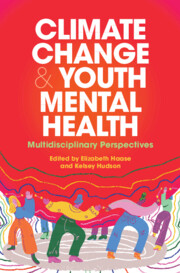Book contents
- Climate Change and Youth Mental Health
- Climate Change and Youth Mental Health
- Copyright page
- Contents
- Figures
- Tables
- Textboxes
- Contributors
- Preface and Introduction
- Considerations
- Acknowledgments
- Part I Conceptual Foundations of Climate Distress in Young People
- Part II Multidisciplinary Perspectives on Youth Climate Distress
- Chapter 10 Therapists’ Perspectives
- Chapter 11 Ecological and Intersectional Perspectives to Reduce Young Adults’ Climate Distress
- Chapter 12 Pediatricians’ Perspectives
- Chapter 13 A Legal Perspective on Judicial Remedies to Respond to Young People’s Climate Distress
- Chapter 14 Coping with Climate Change among Young People
- Chapter 15 Social-Ecological Perspectives and Their Influence on Climate Distress in Young People
- Chapter 16 Parenting and Grandparenting Our Youth in the Climate Crisis
- Chapter 17 Perspectives on Addressing Young People’s Climate Distress in Education
- Chapter 18 Activists’ Perspectives
- Chapter 19 Perspectives from Creative Spaces
- Chapter 20 Landback
- Chapter 21 Future Directions
- Appendix A Resource List for Educators
- Appendix B Costs and Benefits of Activism Scale
- Index
- References
Chapter 10 - Therapists’ Perspectives
Psychotherapeutic Techniques with Applicability to Climate Distress
from Part II - Multidisciplinary Perspectives on Youth Climate Distress
Published online by Cambridge University Press: 06 June 2024
- Climate Change and Youth Mental Health
- Climate Change and Youth Mental Health
- Copyright page
- Contents
- Figures
- Tables
- Textboxes
- Contributors
- Preface and Introduction
- Considerations
- Acknowledgments
- Part I Conceptual Foundations of Climate Distress in Young People
- Part II Multidisciplinary Perspectives on Youth Climate Distress
- Chapter 10 Therapists’ Perspectives
- Chapter 11 Ecological and Intersectional Perspectives to Reduce Young Adults’ Climate Distress
- Chapter 12 Pediatricians’ Perspectives
- Chapter 13 A Legal Perspective on Judicial Remedies to Respond to Young People’s Climate Distress
- Chapter 14 Coping with Climate Change among Young People
- Chapter 15 Social-Ecological Perspectives and Their Influence on Climate Distress in Young People
- Chapter 16 Parenting and Grandparenting Our Youth in the Climate Crisis
- Chapter 17 Perspectives on Addressing Young People’s Climate Distress in Education
- Chapter 18 Activists’ Perspectives
- Chapter 19 Perspectives from Creative Spaces
- Chapter 20 Landback
- Chapter 21 Future Directions
- Appendix A Resource List for Educators
- Appendix B Costs and Benefits of Activism Scale
- Index
- References
Summary
Clinical work with climate-distressed youth using a developmental framework is described, from two theoretical perspectives: acceptance and commitment therapy (ACT) and psychodynamic psychotherapy. General principles of climate-informed therapy are delineated, and case examples illustrate the use of theory in practice. Interventions involving the family, psychoeducation, resilience-building skills, developing a conscious relationship to nature, engaging in environmentally beneficial actions, increasing the tolerance for uncertainty, and developing career goals around the needs of a changing environment and society are described. The authors discuss the need for the clinician to prepare themselves for the challenges of this work, which include one’s own reactions of emotional distress when youth bring this topic up. Ways the clinician can model responses to climate distress are discussed, including staying informed about the multiple unfolding, intersecting crises, and tolerating a multitude of emotional reactions attendant to this urgent situation. The clinician is encouraged to have and use play materials that can be adapted to environmental themes. The importance of providing a secure attachment relationship to use as a base in “weathering the storms” of the climate crisis is emphasized.
Keywords
- Type
- Chapter
- Information
- Climate Change and Youth Mental HealthMultidisciplinary Perspectives, pp. 189 - 209Publisher: Cambridge University PressPrint publication year: 2024

